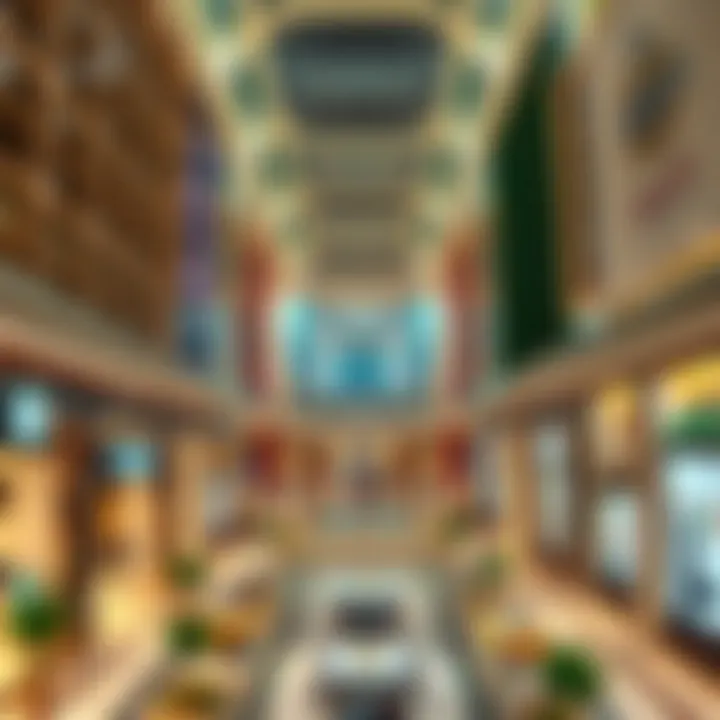Exploring Dubai's Malls: A Retail Journey


Intro
Dubai has firmly established itself as a premier shopping destination, attracting visitors from all corners of the globe. With its sprawling malls that house everything from high-end designer boutiques to local artisan shops, the retail landscape of this vibrant city offers a multifaceted experience for both consumers and investors alike. The malls are not mere shopping venues; they represent a dynamic blend of culture, commerce, and community that reflects the diversity of Dubai itself.
In this article, we explore the shopping experiences found in Dubai’s malls, examining the various retail outlets, consumer behaviors, and marketing approaches that make these hubs of activity so unique. This exploration goes beyond just the shopping, delving into how these spaces contribute to the overall economy of Dubai and how cultural elements influence the consumer experience.
By analyzing factors such as location, demographics, and emerging trends, we aim to provide insights that are invaluable to potential investors, retailers, and consumers. Understanding the retail landscape here not only helps one appreciate the magnificence of Dubai’s malls but also offers a clearer perspective for those looking to make informed decisions in this bustling market.
Let's embark on this journey through the vibrant shopping scene of Dubai, uncovering what lies beneath the surface of these iconic retail destinations.
Prolusion to Retail in Dubai
The retail landscape in Dubai is nothing short of a fascinating mosaic, characterized by luxurious shopping destinations, cultural expressions, and a diverse population. Understanding this environment is crucial for stakeholders including investors, retail professionals, and consumers, as it provides a glimpse into the heart of Dubai's economy. The significance of retail in Dubai extends well beyond simple consumer transactions; it encapsulates the economic vitality of the city, reflecting trends that shift with both global influences and local cultural nuances.
The forthcoming sections will delve into various elements that shape retail in the UAE. Insights into the economic backdrop will offer context for understanding how the retail scene has evolved. Dubai's malls have become landmarks in their own right, serving not only as shopping venues but as social hubs and tourist attractions. They play an instrumental role in bolstering the local economy and attracting millions of visitors each year.
This exploration aims to equip potential investors and real estate professionals with a comprehensive understanding of the dynamics at play in Dubai's retail sector. By gauging current trends and consumer behavior, it will shed light on the wide-ranging effects and opportunities present in this vibrant marketplace.
Overview of Dubai's Economic Climate
Dubai’s economic climate is often viewed through the lens of its ambitious growth narrative. Over the past few decades, the city has transformed itself from a modest trading port into a global economic powerhouse. Key sectors fueling this growth include tourism, real estate, and retail. Tourism alone represents a significant portion of its GDP, with millions flocking to the emirate each year, eager to experience its attractions, which prominently feature its extensive shopping offerings.
Investors have recognized Dubai as a premier destination for commerce and trade, leading to an environment where luxury and lifestyle brands flourish. The government actively promotes a favorable business climate through policies aimed at attracting foreign investments, making it relatively easier to start and manage retail operations.
"Dubai has emerged as a testbed for retail concepts, where innovation meets commerce—a magnet for brands seeking to expand their presence in the Middle East."
This landscape is further complicated by the strong influence of regional and global economic factors, which can sway consumer confidence and spending patterns. Understanding these elements is key for anyone looking to navigate the retail waters in Dubai.
The Role of Malls in Retail Development
Malls in Dubai serve as much more than mere shopping centers; they are pivotal players in the retail development narrative. Celebrated locales like the Dubai Mall and Mall of the Emirates epitomize the marriage of consumerism and entertainment, offering experiences that lure both residents and visitors alike.
- Social Interaction: Malls facilitate social gatherings, making them vital in building community ties.
- Cultural Events: Many malls host cultural events, showcasing local art and talent, which enriches the shopping experience.
- Lifestyle Integration: The fusion of shopping, dining, and leisure activities makes these venues holistic experiences for consumers.
As retail environments, these malls adapt to changing consumer behaviors by incorporating technology and innovative designs. From augmented reality experiences to an emphasis on sustainability, malls in Dubai are constantly evolving to meet the demands of a discerning consumer base.
To sum up, the interrelation between the economic climate and the upscale mall culture in Dubai presents a uniquely advantageous landscape. With consumer preferences shifting rapidly, understanding these key dynamics is essential for anyone invested in or affected by retail trends in the area.
An Overview of Major Malls in Dubai
Understanding the landscape of major malls in Dubai is essential for grasping the broader retail environment. These commercial giants not only house a multitude of shops but also shape consumer behaviors, lifestyle preferences, and overall cultural engagement within the city. Malls like Dubai Mall, Mall of the Emirates, and Ibn Battuta Mall serve as more than just shopping destinations; they are pivotal in driving tourism, contributing to the economy, and ensuring that the city remains a global shopping hub. In this section, we will delve into the distinctive features of these malls, examining their appeal to both locals and tourists.
Dubai Mall: A Definitive Attraction
Key Features and Anchor Stores
Dubai Mall stands as a titanic emblem of retail excellence. It boasts a staggering variety of anchor stores, including Harvey Nichols and Galeries Lafayette, drawing shoppers in by the droves. The sheer size of this mall is awe-inspiring—housing over 1,200 retail outlets. The presence of luxury boutiques alongside high-street brands creates a harmonious blend that caters to all wallet sizes.
One key characteristic of the mall is its strategically designed layout, which allows for easy navigation amidst perhaps too many options. Each section feels distinct yet unified, ensuring that shoppers remain engaged without feeling overwhelmed. Moreover, the integration of entertainment options, such as an aquarium where one can glimpse marine life right next to high fashion, adds a unique flavor to the shopping experience. The advantage of these offerings lies in their ability to attract both serious shoppers and casual browsers, fostering a relaxed and enjoyable atmosphere.
The Mall's Cultural Significance
Cultural experiences are crucial in defining Dubai Mall's identity. It serves as a melting pot, reflecting the city’s multicultural essence. The mall includes art installations and hosts workshops, enriching the typical shopping trip with a glimpse into Middle Eastern art and culture.
What sets Dubai Mall apart is its role in promoting these cultural narratives. By featuring local artists and their works, the mall becomes a venue where commerce meets community. This unique feature not only enhances the shopping experience but also establishes a connection to the city’s rich heritage. The disadvantage, however, could be that some visitors may feel overwhelmed by the sprawling nature of the mall, which might detract from the depth of engagement with these cultural elements.
Mall of the Emirates: Luxury Meets Leisure
Recreational Facilities Inside the Mall


Mall of the Emirates presents a remarkable fusion of shopping and recreation. The famous Ski Dubai, an indoor ski resort, is one of its cornerstone features, attracting adventure-seekers and families alike. This contrast between retail and leisure creates a unique shopping atmosphere, allowing visitors to have fun beyond traditional purchases.
The mall's key characteristic is its ability to cater to leisure while shopping. With cinemas and family entertainment areas, it effectively transforms a shopping day into an experience. Shoppers can enjoy a light-hearted outing or indulge in a thrilling adventure, making it an appealing destination for a diverse audience. The advantage of such offerings is clear — it transforms a mundane shopping trip into a full-day excursion, ensuring that visitors will return.
Luxury Retail Offerings
Luxury is a defining theme at the Mall of the Emirates. Featuring brands like Chanel, Dior, and Gucci, it caters predominantly to high-end consumers. This mall positions itself not only as a shopping center but as an upscale lifestyle hub.
A notable aspect of its luxury retail offerings is the array of exclusive products and limited editions available, which draws affluent shoppers from around the globe. This creates a beneficial impression of being at the forefront of luxury shopping in the region. However, there is also a disadvantage for budget-conscious shoppers; the focus on luxury can alienate those looking for more affordable options, which may limit broad appeal.
Ibn Battuta Mall: Shopping Beyond Borders
Architectural Design and Themes
Ibn Battuta Mall is unique in its thematic representation of different cultures, inspired by the travels of the famous explorer, Ibn Battuta. This architectural gem is strategically divided into sections, each reflecting a distinct region such as China, India, and Persia.
This key characteristic of thematic shopping creates an immersive experience that transcends mere retail. Shoppers can experience diverse cultural aesthetics and architectural styles as they move from one section to the next. Each area showcases how interconnected the world can be while celebrating uniqueness. The advantage is that it attracts tourists keen on exploring various cultures without leaving the mall—creating a cultural journey through shopping.
Cultural Retail Representation
Ibn Battuta Mall goes beyond selling goods; it is a showcase of cultural retail representation. Local artisans and brands give shoppers an opportunity to purchase unique products that tell a story, aligning closely with the desires of tourists looking for memorabilia that reflects their travels.
This notable feature emphasizes the importance of supporting local craftsmanship while also appealing to users of cultural diversity. Such representation transforms a shopping trip into a meaningful engagement with local history and tradition. However, a disadvantage might arise from the limited scope of international brands present compared to other malls, potentially narrowing the options for more traditional shopping experiences.
Shopping Trends and Consumer Behavior
Understanding shopping trends and consumer behavior is crucial in today’s retail landscape, especially in a dynamic market like Dubai. During the recent years, the shopping habits of consumers have been undergoing significant changes. The interplay of the local population and the flux of diverse tourists shapes the retail environment uniquely. Knowing these trends provides deep insights into what drives consumer decisions, and it’s especially relevant as investment opportunities surface in the vibrant Dubai retail scene. By dissecting consumer behaviors, stakeholders will find ways to align their marketing strategies and product offerings wisely.
Demographics of Mall-goers
Diving into the demographics of mall-goers isn’t just about numbers and statistics; it’s a lens through which we can view the wider retail picture. It’s essential to understand who the shoppers really are to identify what they seek in their shopping expeditions in Dubai’s malls.
Local vs. Tourist Shopping Patterns
When we talk about local versus tourist shopping patterns, there's a considerable distinction between their motivations and expectations. Local shoppers often look for practicality and value as they navigate their daily lives. They tend to gravitate towards essential goods while seeking quality and price balance.
On the other hand, tourists are often influenced by novelty and brand experiences, leaning towards memorabilia or luxury shops. This creates a colorful spectrum in shopping preferences, where malls cater distinctly to both segments. Local shoppers cultivate loyalty with certain shops, while tourists often engage in lush, one-off shopping sprees.
Key Characteristic: Local shoppers frequently buy items that reflect the culture or satisfy their immediate needs, whereas tourists may splurge on high-end products or unique gifts that symbolize their visit.
Understanding these patterns allows retailers to tailor promotions and inventory effectively, optimizing sales potential while maximizing customer satisfaction.
Age and Gender Dynamics in Retail Preferences
Age and gender significantly influence retail preferences as well. Younger consumers, for instance, often gravitate towards tech gadgets and trendy apparel, seeking what their peers rave about. This group tends to value social media trends and influencer endorsements, impacting their shopping decisions heavily.
Meanwhile, older customers might focus more on reliability and brand reputation, often opting for traditional luxury brands or useful home products.
Unique Feature: Different age groups highlight distinct shopping priorities, making it advantageous for retailers to cater specifically to these demographics, leading to personalized marketing and improved customer relations.
Emerging Trends in Shopping Experiences
The shopping experience is not stagnant; it's evolving. To remain competitive, stakeholders need to recognize emerging trends that shape the shopping experience significantly.
The Impact of Online Shopping
The rise of online shopping has transformed consumer behavior dramatically. Not only has it made shopping convenient, but it has also reshaped consumers' expectations. Today, consumers often research products online before visiting physical stores, creating a need for a harmonious blend of in-store and online experiences.
Retailers who leverage e-commerce effectively can reach a wider audience, thus driving more traffic to their physical locations. However, the challenge lies in converting online interest into in-store purchases.


Key Characteristic: Understanding this impact allows retailers to develop omnichannel strategies that ensure a seamless shopping experience, providing convenience while fostering a deeply engaged customer base.
The Trend Towards Sustainable Retailing
Sustainability has become a central theme in many consumers' shopping habits. An increasing number of shoppers are becoming more conscious of environmental issues and looking for brands that emphasize eco-friendly practices. Businesses that adopt sustainable practices, such as minimizing waste and sourcing materials ethically, can attract these customers effectively.
Unique Feature: This trend encourages brands to innovate and communicate their values transparently. Retailers that align with sustainable practices not only appeal to a growing market but also carve out a niche in which they stand apart from competitors.
To sum up, understanding shopping trends and consumer behavior in Dubai's malls offers invaluable insights for investors and retailers alike, helping them to navigate the evolving landscape and make informed decisions.
Marketing Strategies within Malls
In a market as vibrant as Dubai’s, marketing strategies within malls aren't just a mere accessory; they’re an essential ingredient that determines the success of retail businesses. The interplay between what draws customers into a mall and what keeps them there is a complex dance of psychology and design. Addressing this topic reveals how shopping centers not only serve the transactional needs of consumers but also create an immersive experience that resonates with their desires and preferences.
The Psychology of Mall Layout and Design
Understanding the psychology behind mall design illuminates how spatial arrangements influence shopping behaviors. Malls often employ a "gravitational method" in which popular anchor stores are placed at strategic points, luring shoppers deeper into the complex. Subtle cues like lighting, sounds, and even scents can guide visitors toward various retail havens.
For instance, the Dubai Mall uses open spaces complementing its intricately designed walkways to create a sense of exploration. Shoppers are more likely to browse than to hustle through stores in a well-designed space. This fluidity in layout not only enhances the overall shopping experience but also increases impulse purchases.
Moreover, integrating leisure areas — such as cafés and entertainment zones — can extend shoppers’ visits significantly. This leads to increased spending while embedding the mall itself as a social environment, not just a marketplace.
Event Marketing and Consumer Engagement
Engaging customers through event marketing is vital in a competitive landscape. Events create buzz and provide an opportunity for unique consumer interactions that can lead to fostering brand loyalty.
Seasonal Promotions and Festivals
Taking advantage of seasonal shifts and festivals can weave a narrative around shopping experiences. Seasonal promotions don’t just serve to spike sales; they also invoke emotions associated with the festivities. For example, during the Eid celebrations, malls in Dubai often host elaborate events featuring cultural performances and themed decorations. This aspect can create a festive atmosphere that motivates families to visit malls as destinations for entertainment rather than mere shopping.
These promotions are characterized by special discounts, limited-time offers, and localized items that resonate with cultural sentiments. Such tailored events not only attract foot traffic but also transform the shopping experience into a memorable, communal affair.
However, a downside is the potential for over-commercialization, leading some consumers to feel overwhelmed by the noise and bustle of constantly ongoing events. Balance is key to ensuring that promotions enhance rather than detract from the shopping environment.
Influencer Collaborations and Their Impact
Collaborating with influencers represents a powerful strategy for driving interest and footfall in malls. These partnerships lend credibility to brands and introduce them to broader audiences, leveraging the personal touch that social media offers.
Influencers often bring their unique flair, creating content that showcases not only specific products, but also the mall ambiance itself. This can significantly affect potential customers’ perceptions and entice them to explore what the mall has to offer. Consider, for example, a local fashion influencer sharing a day in their life, complete with shopping trips to various stores in Mall of the Emirates.
However, the effectiveness of influencer marketing can vary. Not all collaborations generate the same level of engagement or return on investment. Nevertheless, when done right, it can invigorate a mall's brand image and create buzz that gets consumers talking and visiting.
Through the prism of event marketing and thoughtfully curated influencer collaborations, malls can not only attract visitors but also actively involve them in a richer shopping experience. Combining these strategies effectively can lead to a sustainable customer base and a thriving commercial environment.
Investment Opportunities in the Retail Sector
Exploring potential investment opportunities within the retail sector in Dubai’s malls unveils a landscape rich with promise and growth. This segment is critical, particularly for stakeholders who intend to capitalize on the city’s booming shopping scene. The robust influx of tourists and a affluent local populace continually fuels demand for diverse shopping experiences, making it a fertile ground for retail ventures. Furthermore, the ongoing development of infrastructure and tourism initiatives enhances the appeal of investing in this sector.
The significance of investing in retail in Dubai can be distilled into several key factors. First, the strategic location of these malls, especially those situated in areas with high foot traffic, can dramatically increase visibility and sales. Second, the integration of cutting-edge technology, such as cashless payment systems and mobile apps for shopping, provides a competitive edge. Lastly, engaging in partnerships with established international brands can provide a boost in credibility and draw in customers looking for quality and variety.
Here are some notable considerations:
- High foot traffic: Malls like The Dubai Mall and Mall of the Emirates are destinations on their own, attracting millions of visitors annually.
- Diverse demographic: The blend of locals and tourists enriches the customer base, providing varying preferences for shopping.
- Government support: Emirates drive to boost retail through initiatives offers potential funding options and incentives for new businesses.
As the retail landscape continues to evolve, recognizing these factors can pave the way for successful investments.
Market Analysis for Retail Investment
A thorough market analysis reveals the dynamics shaping the retail sector in Dubai. Understanding prevailing consumer trends helps investors make informed decisions. Currently, there are several noteworthy trends to observe:


- Rise of e-commerce: While physical stores hold their ground, e-commerce is growing rapidly, urging traditional retailers to adapt.
- Focus on experience: Shoppers today seek more than just products; they crave experiences that connect emotionally, prompting retail spaces to innovate.
- Sustainability: Growing environmental awareness has led to an increase in brands that prioritize sustainable practices. Investors should lean towards these brands to align with this consumer attitude.
Additionally, certain segments within the retail sector such as luxury goods, electronics, and lifestyle products are witnessing rapid demand increase. Several research reports suggest a projected growth rate much higher than the global average, reinforcing the viability of investment in this area. Investors should therefore keep an eye on niche markets and emerging brands that cater to an evolving audience.
Case Study: Successful Retailers in Dubai
Investing insights can be greatly enhanced by examining successful retailers in Dubai who have effectively tapped into the market’s potential. One such case is Al-Futtaim Group, a prominent player in the region, known for its retail outlets that span various sectors including auto, electronics, and lifestyle.
With a robust strategy of leveraging both local culture and global brands, Al-Futtaim has become synonymous with quality shopping experiences. Their approach emphasizes:
- Customer-centric focus: By engaging customers through loyalty programs and personalized services, they successfully retain clientele.
- Product diversification: Offering a wide range of products ensures they cater to various consumer needs while keeping shoppers coming back.
- Community engagement: Al-Futtaim invests in local initiatives which strengthen its brand image and foster goodwill among residents.
Another example is Spinneys, a grocery retailer that has thrived by focusing on organic and high-quality products, appealing to the health-conscious demographic. Their success hinges on:
- Quality over quantity: Investing heavily in sourcing fresh and organic products has positioned them as a premium brand.
- Adaptability: Staying responsive to market needs has allowed Spinneys to expand its footprint in a highly competitive market.
These case studies illustrate not just the investment potential but also the strategies that lead to successful retail operations in Dubai. Investors must learn from these examples to effectively navigate the complexities of the retail environment.
Challenges and Considerations
Understanding the hurdles faced by retail malls in Dubai is crucial for those invested or interested in the region's retail landscape. The interplay of competition from e-commerce platforms and the potential impact of economic fluctuations can significantly affect foot traffic and, ultimately, sales. Analyzing these factors helps investors and stakeholders make informed decisions while also enhancing the shopping experience for consumers.
Competition from E-commerce
E-commerce has reshaped how consumers shop, making convenience a primary driver in retail choices. With just a few clicks, buyers can access a world of options from the comfort of their homes. In cities like Dubai, where technology adoption is high, this trend poses a significant challenge for physical stores in malls.
- Accessibility: Buying products online saves time and often money, making it tough for brick-and-mortar stores to compete.
- Diversity: Online platforms, such as Amazon and Noon, offer an almost endless range of products, sometimes at lower prices due to reduced operating costs.
- Consumer Expectations: Shoppers now expect a seamless blend of online and offline experiences. They might browse products in-store before making purchases online.
This competition compels traditional malls to rethink their strategies. Instead of merely showcasing products, malls need to focus on providing unique experiences that can't be replicated online, such as interactive displays or community events.
"The modern shopper leans toward convenience; thus, retail adaptations are essential for survival in shifting marketplaces."
Navigating Economic Fluctuations
Economic stability is essential in safeguarding the retail sector. For Dubai, fluctuations can arise from various factors such as shifts in oil prices, global economic conditions, or local policies. These fluctuations affect consumer confidence and spending power, both of which are vital to retail health.
- Consumer Spending: When economic conditions sour, luxury purchases often dwindle first, affecting high-end retailers in malls.
- Occupancy Rates: Fluctuating economic climates can lead to increased vacancies as stores close or relocate, impacting foot traffic and the overall mall ecosystem.
- Investment Risks: Economic uncertainty can slow investment in new projects, making stakeholders wary of committing to expansions in the mall sector.
Navigating these uncertainties involves responsive planning and flexibility in operations. Retailers and mall managers might need to adjust their marketing strategies, diversify their offerings, and remain attuned to consumer sentiment. Clearer insights into economic trends can aid them in staying ahead of the curve.
Ensuring that the retail experience remains engaging and relevant in a rapidly changing environment not only embraces modern challenges but also leverages them. By understanding and addressing these obstacles, the malls in Dubai can continue to thrive as vital components of the retail landscape.
End and Future Perspectives
In wrapping up the exploration of Dubai's retail landscape, it becomes crucial to assess the future trajectories that the mall shopping experience may take. The importance of this topic cannot be overstated, as it directly affects various stakeholders, from investors eyeing profitable opportunities to consumers seeking unparalleled shopping experiences.
The current retail environment in Dubai is shaped by changing consumer demands and technological advancements. Malls are not just retail centers; they are evolving into experience hubs. In this light, it’s advantageous for stakeholders to remain agile and responsive to these shifts. Every detail, from mall design to marketing strategies, must be continuously aligned with consumer preferences while also forecasting future trends.
The Future of Retail Malls in Dubai
As we look ahead, the retail landscape in Dubai will likely change more over the next few years than it has in the past. With digital transformation driving much of this change, malls that adapt will thrive. Here are some elements to consider:
- Integration of Technology: Malls may implement augmented reality experiences to elevate shopping, providing consumers with enhanced product information and interactive displays.
- Sustainability Initiatives: The trend towards eco-friendly practices is gaining momentum. Malls could focus on incorporating sustainable designs, energy-efficient systems, and waste reduction initiatives to appeal to the eco-conscious shopper.
- Experiential Retailing: Retailers need to embrace sensory experiences. Dining options, art installations, and cultural events within malls can enhance foot traffic and keep customers engaged longer.
- Omni-channel Strategies: To compete with e-commerce, malls will need to create seamless experiences that blend online shopping with physical presence.
Plans for future expansions or renovations should consider these aspects if they wish to remain relevant in a competitive environment.
Final Thoughts for Stakeholders
Addressing the future requires a collaborative approach between various stakeholders in the retail sector. Here are key considerations:
- Market Research: Stakeholders must invest in deep market analysis to stay tuned with consumer sentiment and anticipate changes in buying behavior.
- Partnerships and Collaborations: Retailers can benefit from forming partnerships with tech companies to innovate and improve the mall experience.
- Focus on Community Engagement: Building a sense of community through local events and festivals can draw shoppers in, creating loyal patronage.
The retail future is one of collaboration and adaptability. Malls must evolve or risk fading into obscurity.
Investors, retailers, and mall developers all play a crucial role in shaping this dynamic environment. The stakes are high, but so are the rewards for those willing to innovate and adapt to the changing tides.







